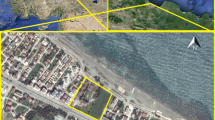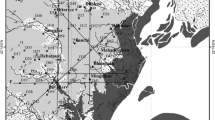Abstract
The paper evaluates the liquefaction potential of the subsoil layers at the town of Larissa (Thessaly Plain, Central Greece). Using data from 53 borings with SPT measurements, the liquefaction potential was evaluated based on simplified procedures and by applying the methodology of the liquefaction potential index to the parameters of the soil columns. Maps were developed indicating the quantitative characteristics of the liquefiable layers and the area where there was a probability of surface evidence of liquefaction. The study indicated that the urban area of Larissa should be considered as a low liquefaction area, with the exception of a few sites close to the River Pinios where the liquefaction potential was characterized as medium to high.
Résumé
L’article évalue le potentiel de liquéfaction de couches du sous-sol de la ville de Larissa (Plaine de Thessalie, Grèce centrale). A partir des données de 53 forages comportant des mesures SPT, le potentiel de liquéfaction a été évalué suivant des procédures simplifiées et en appliquant la méthodologie de l’indice de potentiel de liquéfaction en colonnes de sols. Des cartes ont été établies indiquant les caractéristiques des couches liquéfiables et les surfaces où il y avait une probabilité de liquéfaction. L’étude a conclu que la zone urbaine de Larissa devrait être considérée comme une région de faible potentiel de liquéfaction, à l’exception de quelques sites près de la rivière Pinos où le potentiel de liquéfaction a été défini comme moyen à élevé.









Similar content being viewed by others
References
Andrews DCA, Martin GR (2000) Criteria for liquefaction of silty soils. In: Proceedings of 12th world conference on earthquake engineering, Upper Hutt, New Zealand, NZ society for earthquake engineering, paper no. 0312
Bray J, Sancio R (2006) Assessment of the liquefaction susceptibility of fine-grained soils. J Geotech Geoenviron Eng 132(9):1165–1177
Caputo R, Helly B (2005) The Holocene activity of Rodia Fault, Central Greece. J Geodyn 40:153–169
Caputo R, Pavlides S (1993) Late Cainozoic geodynamic evolution of Thessaly and surroundings (central-northern Greece). Tectonophysics 223:339–362
Caputo R, Helly B, Pavlides S, Papadopoulos G (2004) Palaeoseismological investigation of the Tyrnavos Fualt (Thessaly, Central Greece). Tectonophysics 394:1–20
Cramer CH, Rix GJ, Tucker K (2008) Probabilistic liquefaction hazard maps for Memphis, Tennessee. Seismol Res Lett 78 (in press)
Crespanelli T, Madiai C, Vannucchi G (1999) Zoning for liquefaction risk in an Italian coastal town using CPT. Earthquake Geotechnical Engineering, A. A. Balkema, Rotterdam, pp 561–566
Divakarla PK, Hoyos LR Jr, Macari EJ (1998) Assessment of liquefaction potential of western Puerto Rico. In: Proceedings of 3rd geotechnical earthquake engineering and soil dynamics conference. ASCE, Reston, pp 530–541
EAK (2000) Greek seismic code. Earthquake planning and protection organization, Athens, Greece, pp 72 and 7 Appendices (in Greek)
Galanopoulos GA (1981) The damaging shocks and the earthquake potential of Greece. Ann Geol Pays Hell 30:648–724
Hayati H, Andrus R (2007) Liquefaction potential map of Charleston, South Carolina, based on the 1886 earthquake. Final report to the US Geological Survey (06HQGR0058)
Holzer TL (2008) Probabilistic liquefaction hazard mapping. Geotech Earthq Eng Soil Dyn IV, GSP 181, ASCE
Holzer TL, Bennett MJ, Noce TE, Padovani AC, Tinsley JC III (2002) Liquefaction hazard and shaking amplification maps of Alameda, Berkeley, Emeryville, Oakland, and Piedmont: a digital database. Open-file report 02-296, US Geological Survey, Menlo Park
Hosseini SMMM (1998) Microzonation for liquefaction in Busehr, Iran. In: Proceedings of 11th European conference on earthquake engineering. (CD-ROM), A.A. Balkema, Rotterdam
Iwasaki T, Tatsuoka F, Tokida K-i, Yasuda S (1978) A practical method for assessing soil liquefaction potential based on case studies at various sites in Japan. In: Proceedings of 2nd international conference on microzonation, pp 885–896
Iwasaki T, Tokida K, Tatsuoka F, Watanabe S, Yasuda S, Sato H (1982) Microzonation for soil liquefaction potential using simplified methods. In: Proceedings of the 3rd international conference on microzonation. 3:1310–1330
Juang CH, Li DK (2007) Assessment of liquefaction hazard in Charleston Quadrangle, South Carolina. Eng Geol 92:59–72. doi:10.1016/j.enggeo.2007.03.003
Kayabali K, West TR (1994) Liquefaction susceptibility evaluation for the City of Evansville, Indiana. Bull Assoc Eng Geol 31(2):231–253
Lee D-H, Ku C-S, Yuan H (2003) A study of the liquefaction risk potential at Yuanlin, Taiwan. Eng Geol 71(1–2):97–117
Lenz JA, Baise LG (2007) Spatial variability of liquefaction potential in regional mapping using CPT and SPT data. Soil Dyn Earthq Eng 27(7):690–702
Li DK, Juang CH, Andrus RD (2006) Liquefaction potential index: a critical assessment using probability concept. Taiwan Geotechnical Society. J Geoeng 1(1):11–24
Liao S, Whitman RV (1986) Overburden correction factor for SPT in sand. J Geotech Eng ASCE 112(3):373–377
LiqIT 4.7 (2006). Software for the evaluation of the liquefaction potential of soils. GeoLogismiki, Serres Greece
Luna R, Frost DJ (1998) Spatial liquefaction analysis system. J Comput Civil Eng 12(1):48–56
Maravelakis (1943) Geological and macroseismic study of the devastating earthquake of Larissa, 1 March 1941, p 27
Papadopoulos G (1992) Rupture zones of strong earthquakes in the Thessalia region, Central Greece. In: Proceedings of the XXIII general assembly ESC Prague. 2:337–370
Papaioannou (1981) The earthquake of 1892, Larissa. Newspaper “Eleftheria”, 15 March 1981
Papathanassiou G (2008) LPI-based approach for calibrating the severity of liquefaction-induced failures and for assessing the probability of liquefaction surface evidence. Eng Geol 96:94–104
Papathanassiou G, Pavlides S, Ganas A (2005) The 2003 Lefkada earthquake: field observations and preliminary microzonation map based on liquefaction potential index for the town of Lefkada. Eng Geol 82(1):12–31
Papazachos BC, Papazachou K (1997) The earthquakes of Greece, Ziti Publ, Thessaloniki, 304 p
Papazachos BC, Comninakis PE, Scordilis EM, Karakaisis GF, Papazachos CB (2007) A catalogue of earthquakes in the Mediterranean and surrounding area for the period 1901–2006, Publications of Geophysical Laboratory, University of Thessaloniki
Rix GJ, Romero-Hudock S (2007) Liquefaction potential mapping in Memphis and Shelby County, Tennessee. Report to US Geological Survey, http:/earthquake.usgs.gov/regional/ceus/products/download/Memphis_LPI.pdf, 27 p
Seed HB, Idriss IM (1971) Simplified procedure for evaluation soil liquefaction potential. J Soil Mech Found Div ASCE 97:1249–1273
Seed HB, Tokimatsu K, Harder LF, Chung RM (1985) The influence of SPT procedures in soil liquefaction resistance evaluations. J Geotech Eng Div ASCE 111(12):1425–1445
Seed RB, Cetin KO, Moss RES, Kammerer AM, Wu J, Pestana JM, Riemer MF, Sancio RB, Bray JD, Kayen RE, Faris A (2003) Recent advances in soil liquefaction engineering: a unified and consistent framework. In: Proceedings of the 26th annual ASCE L.A. Geotechnical Spring Seminar, Long Beach, California, 71 p
Sonmez H (2003) Modification of the liquefaction potential index and liquefaction susceptibility mapping for a liquefaction-prone area (Inegol, Turkey). Environ Geol 44(7):862–871
Sonmez H, Gokceoglu C (2005) A liquefaction severity index suggested for engineering practice. Environ Geol 48(1):81–91
Stewart JP, Liu AH, Choi Y (2003) Amplification factors for spectral acceleration in tectonically active regions. Bull Seismol Soc Am 93(1):332–352. doi:10.1785/0120020049
Toprak S, Holzer TL (2003) Liquefaction potential index: field assessment. J Geotech Geoeng Eng 129(4):315–322
Tsotsos S, Pitilakis K (1995) Microzonation study of Larissa. Department of Civil Engineering, AUTH, Greece, 254 p
Ulusay R, Kuru T (2004) 1998 Adana-Ceyhan (Turkey) earthquake and a preliminary microzonation based on liquefaction potential for Ceyhan Town. Natural Hazards 32(1):59–88
Varnes DJ (1984) Landslide hazard zonation: a review of principal and practice. Commission of Landslide of IAEG, UNESCO. Nat Hazards (3):63
Wang W (1979) Some findings in soil liquefaction, Water Conservancy and Hydroelectric Power Scientific Research Institute, Beijing, China
Youd TL, Idriss IM, Andrus RD, Arango I, Castro G, Christian JT, Dobry R, Finn WDL, Harder LF, Hynes ME, Ishihara K, Koester JP, Liao SSC, Marcurson III WF, Marti GR, Mitchell JK, Moriwaki Y, Power MS, Robertson PK, Seed RB, Stokoe II KH (2001) Liquefaction resistance of soils: summary report from the 1996 NCEER and 1998 NCEER/NSF workshops on evaluation of liquefaction resistance of soils, J Geotech Geoenviron Eng ASCE 127(10):817–833
Acknowledgments
The authors would like to thank Mr. Papaioannou for providing information on the historical seismicity of the area.
Author information
Authors and Affiliations
Corresponding author
Rights and permissions
About this article
Cite this article
Papathanassiou, G., Seggis, K. & Pavlides, S. Evaluating earthquake-induced liquefaction in the urban area of Larissa, Greece. Bull Eng Geol Environ 70, 79–88 (2011). https://doi.org/10.1007/s10064-010-0281-3
Received:
Accepted:
Published:
Issue Date:
DOI: https://doi.org/10.1007/s10064-010-0281-3




